
No one likes to be duped, and finding out you’ve been “had” can be a demoralizing experience. Possibly the best thing to come of it is the ability to spot the next sleight of hand before it is too late.
My Resource Media colleagues and I were contemplating this concept the other day while talking about two fascinating situations where Americans were massively and thoroughly duped thanks to very clever PR campaigns, and it struck us that we might be in the middle of a similarly large-scale deception when it comes to the narrative around racial justice in this country.
Let me explain.
It’s Your Problem: Keep America Beautiful & the Carbon Footprint Calculator
Mashable and the NPR podcast Throughline both recently covered how easily and thoroughly American consumers were manipulated by large beverage and packaging companies with the famous “Crying Indian” PSA campaign in the 1970s. Setting aside the fact that the actor, Iron Eyes Cody, was an Italian American who claimed to be Native American and lived the stereotype by wearing Native garb in his personal life, it turns out the presumably heartfelt effort to get Americans to clean up their trash had a more sinister intent. After the Vermont Legislature passed a law in 1953 banning disposable glass bottles–in response to the problems with broken glass from trash–the packaging industry realized it had a problem on its hands. It created an organization called Keep America Beautiful and spearheaded several initiatives to persuade Americans to not litter–including the so-called “Crying Indian” campaign–as a way to make Americans believe trash and litter were a matter of personal responsibility–not something packaging companies should be held accountable for.
Similarly, as reported by Mashable, in 2004, BP (British Petroleum–whose slogan is Beyond Petroleum — Orwell would be proud) began popularizing the concept of a carbon footprint calculator. As with the Keep American Beautiful campaign, BP’s efforts were intended to convince Americans that carbon pollution was a matter of personal behaviors and responsibility–not the problem of fossil fuel companies who drill, mine, refine and sell the fuels that are the primary cause of climate change. Mashable quotes Benjamin Franta, who researches law and the history of science at Stanford Law School, who noted that the carbon footprint calculator “is one of the most successful, deceptive PR campaigns maybe ever.” Notably, BP produces nearly as much carbon-emissions-causing oil as it did in 2004.
In both cases, large institutions seeking to maximize profit devised narratives deeply grounded in shared American values around personal responsibility and personal accountability to shift attention away from the institutions’ role in creating and reinforcing widespread, collective harm. The new narratives changed what we saw and didn’t see, which informed how we interpreted the problem at hand. Instead of focusing on where all of the glass bottles and other trash were coming from in the first place and why companies had shifted to single-use, disposable packaging, Americans were primed by the industry to focus on what they did with those bottles and other disposable items when they were done with them. Just like that, those bottles were our problem. And instead of seeing the fossil fuel companies who drill, mine and sell the product that causes climate change, the carbon footprint calculator made us all zero in on our individual behaviors associated with those products. And once again, just like that, climate change became our problem too.
So what does all of this have to do with racial justice? It strikes us that so much of how we see problems around racial justice settle on the actions of individuals, and as a result, it’s much harder to see the role that our institutions play in perpetuating and reinforcing systemic racism.
Think of how we talk about and see the problems:
- The rise of call-out and cancel culture is prompting us to scrutinize every word, deed, appearance and association and shame each other for not being righteous enough, good enough…you get the idea.
- People talk about “bad apples” within police forces, making police violence a matter of each individual police officer’s behavior and approach.
- We have an inordinate focus on “doing the personal work,” when it comes to undoing racism, where progress hinges on every individual committing to self-reflection, vulnerability, therapy–whatever it takes to fix things, person by person.
In all of these examples, the problem we see pertains to the individual, and the solutions become the individual’s responsibility. That cop. Her action. His article. Their choice of words.
Our question is this: In focusing our attention on the individual, what are we missing?
I’m reminded of the famous optical illusion, My Wife and My Mother-in-law, by W.E. Hill. Viewed one way, you see a young woman turning away; with a shift in perspective, you see an old woman (the young woman’s necklace becomes the old woman’s mouth). Your eyes can’t see both at once–you can only shift back and forth.
Each shift in perspective is a new narrative. And just like that, narrative prescribes what we see, and what we don’t see.
As we collectively train our eyes on our individual responsibilities and faults when it comes to racial justice, individuals and individual actions and choices come into sharp focus. What blurs in the picture are the institutions and structures that underpin our racist systems. We therefore lose sight of their role and we don’t hold them accountable for the harm they cause.
Can we avoid this sleight of hand? With the shift of our collective eye, can we demand accountability from the institutions that perpetuate racism? Are we ready to look beyond the failures and foibles of each of us as individuals and pay more attention to tax law, financial institutions, educational systems, community zoning policies, healthcare policies, employment practices, policing institutions and the carceral state, and all of the other systems and structures that were designed with racist outcomes in mind?
That’s not to say individual responsibility and accountability doesn’t matter, and it’s not to say we don’t all need to do our personal anti-racist work. But we fear that an inordinate focus on individual responsibility may be by design, and ultimately distract us from the work of building anti-racist institutions.
By Amy Frykman, with contributions from Jenny Park and Marla Wilson
More Insights and Resources


Rooted in who we are: Check out our new look and website

